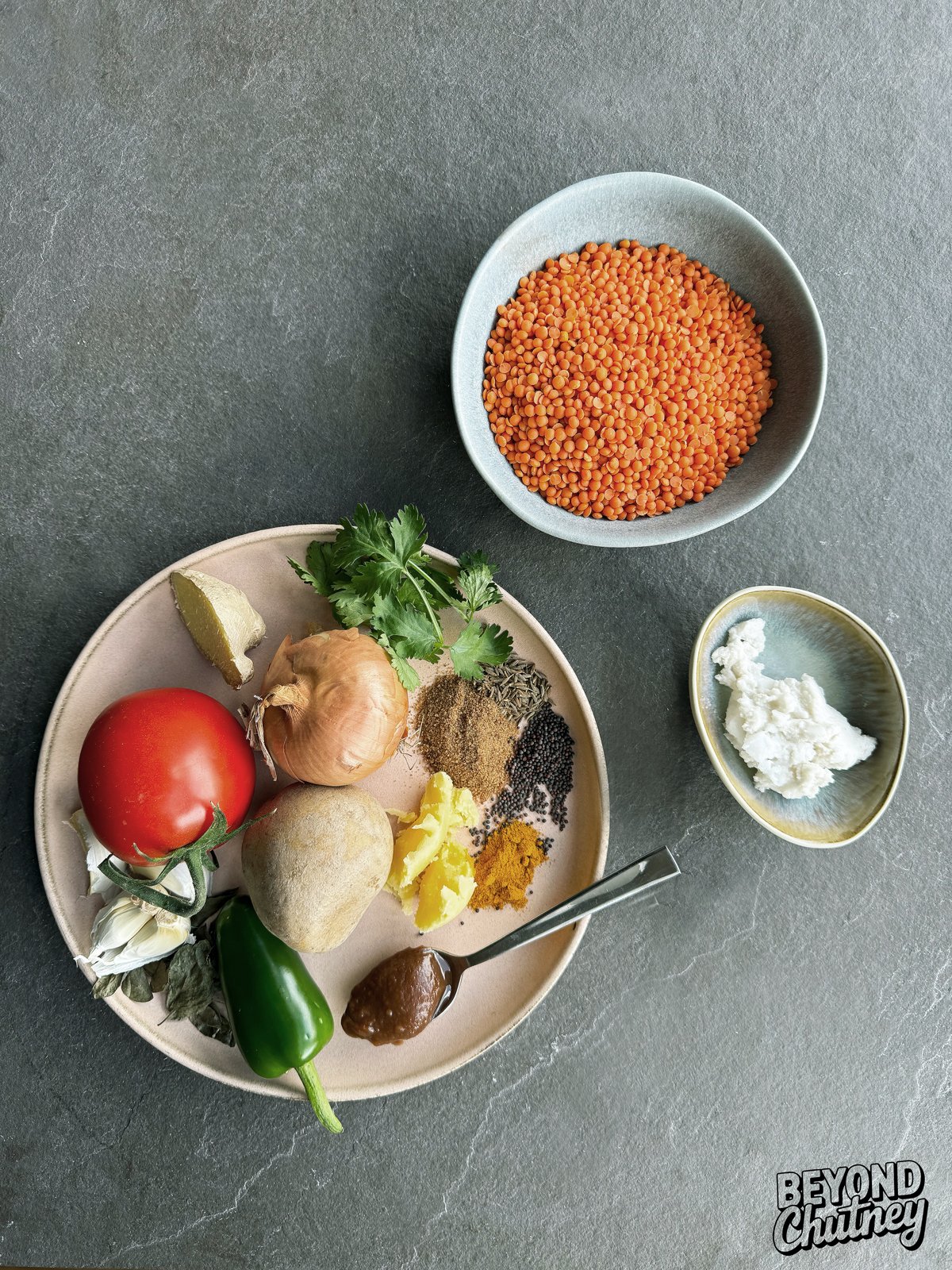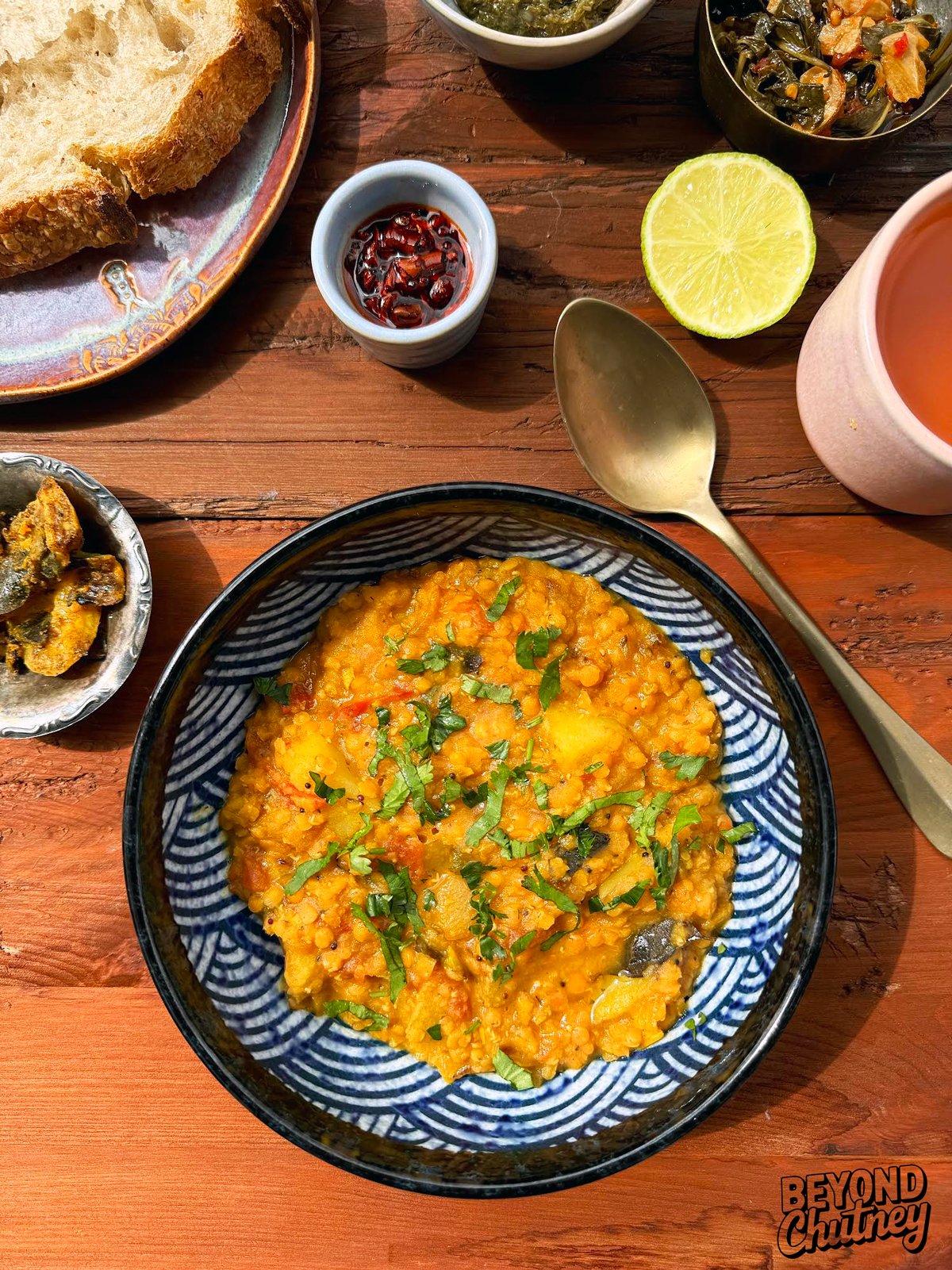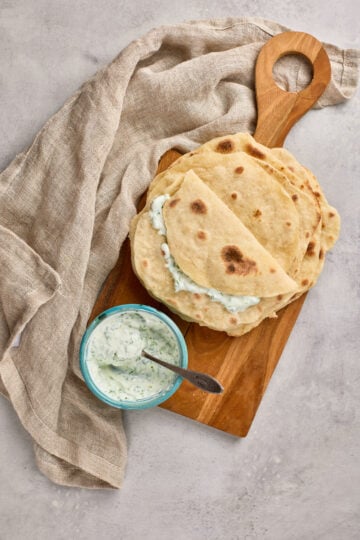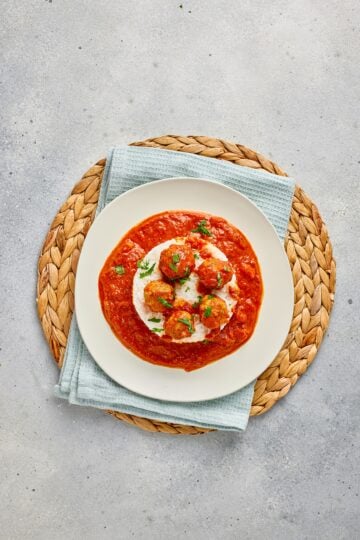I’d read about South Indian flavors using tamarind and coconut milk – and this felt like the perfect way to try them together.
This creamy red lentil curry is inspired by masoor dal, a dish you’ll find in many Indian kitchens. The twist here is a sweet-sour kick from tamarind and a splash of coconut milk – flavors often found in regions like Maharashtra and along the southern coast. The lentils break down into a velvety base, the potato adds heartiness, and the sizzling tadka of spices brings everything to life. Simple, bold and one of my go-to comfort meals.
It’s best served with rice or any warm flatbread — roti, bhatura, naan, or pita or sourdough work great.
Here’s how I put it all together into a cozy, flavor-packed bowl:

Creamy Red Lentil Curry with Potatoes and a Sweet-Sour Kick
Ingredients
- 150 g red lentils masoor dal
- 1 small potato peeled and chopped
- ¾ teaspoon salt
- ½ teaspoon turmeric
- 600 ml water
- 2 tablespoon sunflower oil or ghee
- ½ teaspoon black mustard seeds
- 1 teaspoon cumin seeds
- 10 –12 fresh curry leaves or 1 teaspoon dried, optional
- 2.5 cm fresh ginger finely chopped
- 4 garlic cloves finely chopped
- 1 onion finely chopped
- 1 green chili finely chopped
- 1 tomato finely chopped
- 1 –1.5 teaspoon tamarind paste adjust to taste
- 1 tablespoon coconut sugar optional, for sweet-sour flavor lovers
- 50 –100 ml coconut milk
- 100 ml water
- Fresh coriander chopped
Instructions
- In a pot, bring red lentils, potato, salt, turmeric, and water to a boil. Simmer for about 10–12 minutes, until everything is soft. Lightly mash the potato to make the dal creamy. Set aside.
- Heat oil or ghee in a large pan. Add mustard seeds and let them pop. Then add cumin seeds and curry leaves. Sauté briefly.
- Add ginger and garlic, cook for 1 minute. Add onion and green chili and sauté for 6–8 minutes until golden brown.
- Add tomato, tamarind & coconut milk
- Stir in the tomato and cook for about 5 minutes until soft. Add tamarind paste and (optional) coconut sugar. Finally, stir in the coconut milk and 100 ml water. Bring to a brief boil.
- Stir the tadka mixture into the cooked dal. Taste and adjust seasoning if needed. Stir in fresh chopped coriander and serve.
Notes
- Adjust the tamarind paste to taste — some brands are more sour than others.
- If your dal gets too thick as it sits, just stir in a splash of hot water.
- Fresh curry leaves add a unique aroma, but the recipe still works without them.
- For extra creaminess, use the thicker part of canned coconut milk.
- Leftovers keep well in the fridge for 2–3 days and taste even better the next day.
- Add chopped spinach or kale to the dal for extra greens.
- Swap the potato for sweet potato for a sweeter contrast.
- Stir in a spoonful of peanut butter with the coconut milk for richness.
- Use moong dal or yellow lentils instead of red for a slightly different texture.
- Serve with lemon rice or coconut rice for even more flavor.
Nutrition
FAQ
Can I use other lentils instead of masoor dal?
Yes. You can make this recipe with moong dal (yellow lentils), toor dal (pigeon peas), or even chana dal (split Bengal gram). Each variety has a slightly different cooking time and texture. Red lentils (masoor dal) cook the fastest and give a smooth, creamy consistency. Moong dal produces a lighter, more delicate flavor, while toor dal has a slightly nuttier taste and thicker body.
Is tamarind essential for this recipe?
Tamarind adds a gentle tang that balances the coconut milk’s richness and the natural sweetness of the lentils. If you don’t have tamarind paste, you can use a mix of lemon juice and a small amount of jaggery or brown sugar to mimic that sweet-sour balance. The flavor won’t be exactly the same but still works beautifully.
What can I use instead of coconut milk?
Coconut milk adds a smooth, creamy texture, but you can substitute with cashew cream, almond milk, or even regular dairy milk if preferred. For a lighter version, use water or vegetable stock and finish with a spoonful of yogurt for creaminess. If you’re using canned coconut milk, the thicker top layer will make the curry richer.
How spicy is this curry?
This dish is naturally mild to medium, depending on your chili and mustard seed levels. You can increase the heat by adding extra green chili or a pinch of red chili powder to the tadka. For a milder version, remove the chili seeds or skip the chili altogether.
Can I skip curry leaves?
Fresh curry leaves add a unique aroma and depth typical of South Indian-style dishes. If they’re not available, you can use dried curry leaves or skip them. The dish still tastes great without them — the tamarind and coconut milk already bring strong flavor.
How can I make the dal creamier?
Mash the cooked lentils and potato gently before adding the tadka. For extra creaminess, use the thick part of canned coconut milk or stir in a spoonful of ghee at the end. Letting the curry sit for 10–15 minutes after cooking also helps it thicken naturally.
What should I serve it with?
It’s perfect with steamed basmati rice, jeera rice, or plain roti. It also pairs nicely with naan, pita, or even sourdough bread. For a more filling meal, serve with lemon rice or coconut rice for a layered flavor.
How long does it keep?
The curry keeps well in the fridge for 2–3 days. Store it in an airtight container and reheat gently on the stove, adding a splash of hot water if it thickens. The flavors deepen after a day, making it even tastier.
Can I freeze it?
Yes. This curry freezes well for up to 2 months. Let it cool completely before transferring to a freezer-safe container. Thaw in the fridge overnight and reheat on low heat. Stir well to restore the texture, adding a bit of warm water if needed.
Is this recipe vegan and gluten-free?
Yes, it’s naturally vegan and gluten-free. Just make sure your tamarind paste and coconut milk are free from additives containing gluten.
Can I add vegetables or greens?
Definitely. Chopped spinach, kale, or bottle gourd blend nicely into this curry. Add them toward the end of cooking so they stay bright and fresh. Sweet potato also works well instead of regular potato for a naturally sweeter flavor.
Why does my dal turn too thick after cooling?
Masoor dal continues to absorb liquid as it rests. If your curry thickens after cooling, simply add a bit of hot water while reheating and stir to loosen the consistency.








Have a question or something to share? Leave a comment below!